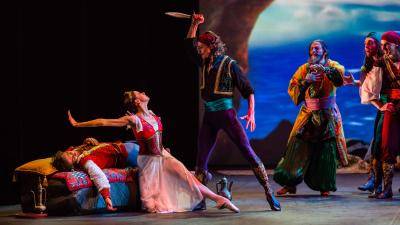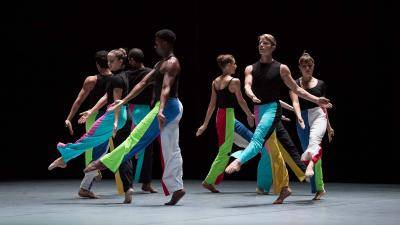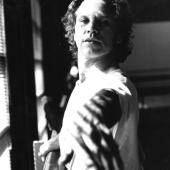Los Angeles Contemporary Dance Company returned to the Diavolo Theater this past weekend with new works by guest choreographers and two works by LACDC Artistic Director, Kate Hutter. Clever titles and high concept contexts prevailed in this program which featured LACDC’s ever shifting cast of dancers, musicians, and choreographers. The major work on the program, Hutter’s, 'Prite Oef Stringh', paid homage to the Stravinsky 'Rite of Spring' Centennial. The evening included three ensemble works and a duo originally choreographed in 2012.
The three ensemble works all shared a sense of social or quasi-tribal connection. 'Rite of Spring' is, of course, all about tribe, and you didn’t have to look far to see the different ways in which that spirit rubbed off on the other works on the program. 'En Route', choreographed by Lindsey Lollie, suggested a journey but with its ending sequence, two dancers walking expectantly toward a bright light, gave no hint of a destination. The five dancers, dressed in street clothes, responded to on stage music by Peter Gonzales (composer, drums, banjo), Louis Lopez (trumpet, laptop), and Sahy Uhns (electronics). En Route offered its most revealing moments in the unison and interactive ensemble sections, and its most poignant moments during Gonzales’ minimalistic but atmospheric, solo banjo interlude accompanying the work’s closing section with dancers Christian Beasley and Kim Thompson. The musical ensemble also played ahead of the concert as the audience was being seated.
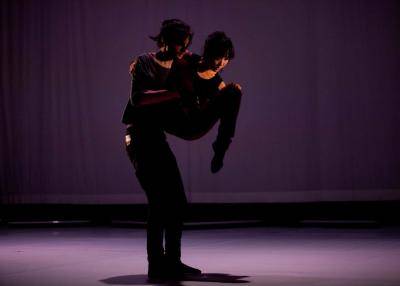
The dangerously named 100 Times Is Not Enough (choreographed by Arianne MacBean) gave Ms Hutter a chance to show off her skills as a dance comic. The work is a humorous gloss on the difficulties of creating dance from scratch. The glowing white floor and backdrop offered potent if obvious symbols of the artist’s blank canvas or the writer’s empty page. The work alternated sections of dance for the ensemble of 16 dancers and acted interludes with Hutter that developed themes of procrastination and insecurity. Also front and center: a self-deprecating look at the contrivances of modern dance. But 100 Times is Not Enough never really soared fully in the dance segments. The dancers, dressed in white with their names printed on tee shirts, came across as versions of modern dance Mouseketeers. In the end, Hutter’s quirky comedy proved the more engaging element in a piece that over balanced the theater and underplayed the dance. The recorded music, a chamber ensemble for strings, was composed by Ivan Johnson.

Prite Oef Stringh (Hutter) remixed both the movement and music of the original. Austin Wintory composed a clever score that borrowed from sections of the original score, overlaying it with samplings and stand-alone music including vocal additions by Holly Sedillos. Hutter’s version gave us three soloists playing the equivalent of the original Rite’s Chosen One. It maintained the threatening tribal implications of the original without embracing an actual story and also soared on the powerful company dynamic of committed dancing.
It felt like a work still finding its legs and didn’t always look secure on stage. Still, it left a powerful impression as it alternated large ensemble sections, and duos or trios with a satisfying sense of architecture. The lighting covered the stage in a visually appealing pattern of dappled light which glowed against the white floor. It gave the set an outdoor appeal. Cribbed from the original were the tripping steps and the groupings of dancers into phalanxes as well as the juxtapositions of pools of quiet followed by explosions in both movement and music. You could have hoped for more visual rhythmic appeal in those sections. The three female soloists were played with courage by Marisa Jimenez, Tiffany Seat, and Melissa Schade. Here they were outsiders and each communicated a palpable emotional distress. The costuming (all white versions of thermal underwear) dressed down the company with an awkward sense of vulnerability. Consider the whole a considerable mountain scaled in addressing the legacy of dance masterwork work that continues to grow in stature.
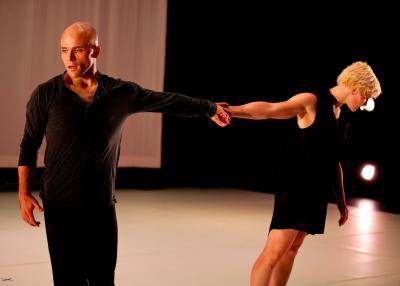
The jewel in the program was the Act II duo danced by Hutter and guest artist, Charlie Hodges. Hodges is currently a dancer with the L.A. Dance Project. Their affectionate dancing in Unravel was as expert as it was touching. In an evening mostly where faces didn’t matter, Hodges especially evinced a pleasure in dancing that was made all the better by seeing the duo danced in small theater. Both dancers looked stellar, roaming the stage in a piece that was in constant, intertwining motion. The music (On Thoughts, from a series of dance derived pieces for string quartet) by Ezio Bosso, reflected a sense of today’s classical minimalism. Hutter’s choreography, rather than being romantic, conveyed a deep sense of partnership, and in the end, repose.

